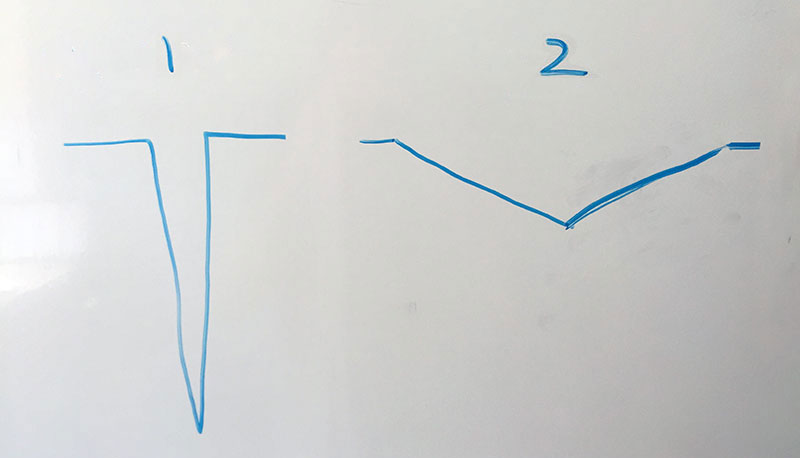A few years ago I founded a startup, but our original idea failed to get traction.
We had to pivot. We needed ideas.
One of of our advisors drew this on a white board. It’s been etched in my memory since.
Creating a product is like digging a hole
The depth of the hole (Y-axis) represents how much your users need and love your product.
The width of the hole (X-axis) represents the number of people who may find your product useful.
Startup ideas tend to fall into two categories:
- Narrow and deep: An extremely small number of people will find it incredibly useful
- Wide and shallow: A huge number of people will find it a little bit useful
The most attractive ideas fall into the 2nd category. But it’s a trap.
People get excited about big, sexy, high-impact visions. Curing cancer. Building a new operating system. Launching a new programming language.
But early startups don’t have the time or money to execute well on big ideas.
I learned this the hard way. We decided to pivot to building an email client to compete with Gmail. Our advantage was that we’d use machine-learning to automatically categorize your email (this was before Priority Inbox). We spent months building our our machine-learning system plus hundreds of features that people expected all email clients to have.
The first version of the product sucked. The email client we built wasn’t good enough for even us, the founders, to use ourselves. I still used Apple Mail and my co-founder used Gmail.
The idea was exciting to work on because it had the potential to reach a huge, wide market, but the usefulness of the early product was too shallow for it to pick up any momentum.
Build products that only a few people LOVE
We should have started smaller. Instead of building a new email client, we could have built a Gmail plugin that added one feature that a small number of people would find extremely useful. This is in line with what Rapportive and Streak has done.
In Sam Altman‘s words, “it’s better to build something that a small number of users love, rather than a large number of users like.”
It’s almost always best to start by building a product that a small number of people will find incredibly useful. Your goal should be to build something that users won’t be able to live without, even if YOU are the only user.
If you’re able to build something that one or two other people truly can’t live without, you know you’re moving in the right direction.
Start by building features, not companies
Y combinator is sometimes criticized for funding “features” instead of “companies”. But if you look back at the most successful companies today, many of them started out as something far smaller than they are now.
The famous example is Microsoft’s first product, Altair Basic. The market size was tiny. Their users were mostly computer hobbyists. But the few users they had, loved it.
If you’re able to build something that a small number of people really love, there’s almost always a way to carve out a larger market for your product by adding features or marketing the product in a new way, as Microsoft has done.
This is why so many great ideas start out as small side projects. With a side project, there’s no question of whether the market for your idea is big enough. It doesn’t matter because it’s just a side project (for now).
When you talk to investors, they’ll ask, “But how will this become a $100mm a year business?” The simple answer is that your product today almost certainly can not become a $100mm business. But the way you expand your product tomorrow, can.
How to grow a tiny idea into a big business
Let’s say you’ve built a niche product that a tiny number of users find incredibly valuable. What’s next?
Your tiny idea is at Point A, and you’re swinging for Point Z (amazing product that reaches a wide market).
Before you can get from Point A to Point Z, you have to traverse the entire alphabet. Each subsequent letter is 2x larger than the previous one.
To get from Point A to Point B, you need to grow your tiny user base by 2x. And once you’re at Point B, you need to 2x your size again to reach Point C.
If you only have 50 users, first figure out how to reach 100 users before you shoot for 100,000.
Growing this way will be slow at first because the absolute numbers are so small. But this is how exponential growth begins.
Here’s an example. Let’s say your SaaS startup has just $100 of monthly revenue. Here’s what happens if you double your revenue every month.
- After 2 months: $400 of monthly revenue. Still tiny.
- After 4 months: $1,600 of monthly revenue. Still pretty small.
- After 6 months: $6,400 of monthly revenue. Getting there!
- After 8 months: $25,600 of monthly revenue.
- After 10 months: $100k of month revenue. WTF!
A company can grow from just $100 of monthly revenue to $100,000 by doubling just 10 times.
The time to double may be longer than 1 month, but this gives you an idea of how powerful exponential growth is.
Instead of thinking “How to I get from Point A to Point Z”, first think about how you will get to point B.
Growing 2x today is a lot easier than shooting for 100x growth in 3 months. Thinking this way allows you to gradually evolve and expand your product over time.
Instead of attempting to leapfrog a tiny idea into to a huge one, take small steps that exponentially increase the reach of your product over time.





